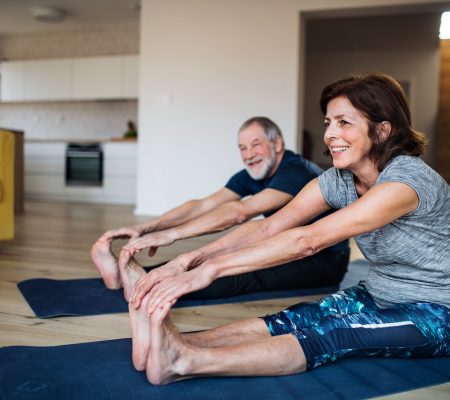Workout At Home: 7 Tips to Keep You Safe and Healthy
A month into the new year, you may still be figuring out how to keep yourself accountable to new fitness goals. Setting up a workout at home routine is an affordable and easy way to keep yourself on track to meet goals. But it might not be as easy as it seems, especially if you’re starting out.
At Orthopaedic Hospital of Wisconsin, we want to help you keep active to prevent orthopedic injury, improve your strength, and recover from any setbacks you might face due to surgery or a chronic condition. Below are a few of our 7 tips to keep working out from home safe and efficient.
1. Create a Workout Schedule
A great aspect of working out from home is that you can do it on your terms and fit a workout whenever works best for your schedule. While this is a huge pro to working out at home, it can also be a con. As we go through our daily schedule, tasks can pile up, and we can easily make excuses as to why we can’t fit in a workout.
To keep yourself accountable, create a workout schedule and block out time during the day dedicated to a workout. Prioritize this time as you would any other important daily task. This way, you ensure you find the time to get moving. You can even use an app or template to help you plan and stay on track.
2. Enjoy Positive Peer Pressure
Working out from home can be more isolating than a group workout class or an in-person gym session. It can be comforting to work out at your own pace, but sometimes positive peer pressure can help to keep you on track and motivate you to move towards your goals.
Try signing up for a fitness app with social features, like Strava or Nike Run Club. With a social fitness app, you can share your workouts with friends. Not everything is a competition, but seeing other people’s workout statistics can help motivate you toward your fitness goals. Plus, making working out social can help you feel less isolated and more supported in your fitness journey.
3. Ease Into it
Some fitness goals can be loftier than others. While it’s great to think about fitness with long-term goals in mind, a vital aspect of at-home workout safety is easing into things slowly. Plus, if you’re starting from square one in your fitness journey, beginning with workouts that are too rigorous is a sure way to burn out and give up.
Slowly, you can increase your workout time and begin to narrow in on specific goals. Remember, you don’t need to dedicate hours of your day to fitness. Even 15 minutes of daily active movement is beneficial.
4. Stay Fueled and Hydrated
If you’re squeezing a home workout into a busy day, it can be easy to forget about eating and drinking water. But staying fueled and hydrated is essential to at-home workout safety. Eating a nutritious diet and drinking plenty of water is necessary to help your body perform optimally and reduce the risk of overheating. A lack of hydration can even result in more serious conditions caused by heat-related illnesses.
Schedule your home workouts with regular meals and drink water throughout the day to stay hydrated.
5. Stay Present in Your Workout
When working out at home, it can be easy to not practice proper form with nobody watching you. Plus, if you are doing your home workout solo, you can get more easily distracted by your surroundings. These slips in your focus can easily lead to an injury.
Before engaging in your workout, silence your phone notifications and do your best to eliminate any distractions in your surroundings. And while moving, try and stay fully engaged with your body. Practice in front of a mirror to ensure you have proper form and stay focused!
6. Check Your Machine Before Use
If your home workout involves an exercise machine, like a treadmill, elliptical, or Peloton, be sure to inspect the machine before you get started. A malfunctioning machine can easily lead to a strained muscle or injury. Once you are positive it is in proper working condition, ensure it is in the correct settings for your body, including the seat height or handlebar position.
7. Stop if You Don’t Feel Well
The most common injuries people who work out at home will experience are overuse and repetitive use injuries. To avoid these injuries, do not work out if you don’t feel well or are experiencing any pain. While exercising, you should feel tension and aches in your muscles. But any sharp pain or aches in your joints means it is time to take a break.
If you are experiencing pain that limits you, do not hesitate to contact the orthopedic specialists at Orthopaedic Hospital of Wisconsin. Our highly rated care teams are here to help you feel pain-free and regain mobility.
To make an appointment, call (414) 961-6800 or fill out an online appointment request form.


